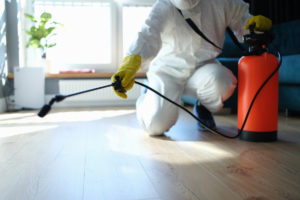Pests are organisms that harm plants or people. Control methods aim to reduce their numbers to an acceptable level and cause as little harm as possible to beneficial or non-target organisms.
Physical and mechanical controls kill or block pests, or make the environment unsuitable. Examples include trapping rodents, mulching for weed control and steam sterilization of the soil for disease management. Contact Pest Control Calabasas CA now!

A pest is any organism that causes damage to crops, plants or animals. This can be direct, such as chewing holes in a crop, or indirect such as spreading disease through contact with the soil, plants or animals. Pests are usually tiny organisms that reproduce quickly, resulting in large populations that can cause serious damage or even threaten human health and the environment.
Correct identification is important for determining whether to control the pest, when, and how. If the pest is a weed, insect, microbe or vertebrate it can often be identified by its physical appearance. In other cases, the pest’s life cycle and environmental factors may help in its identification.
In the field, a key step in pest identification is keeping scouting records to determine what species are present and when they occur. A pest management program can be developed based on these scouting records, as well as on information about the biology and ecology of the pest. Insect identification to the species level is a valuable part of this process, as different insect pests and beneficial insects can have very different interactions with their hosts and natural enemies.
Homeowners can prevent pest problems by eliminating attractants such as water, food and shelter. Regular inspections of the property can help detect pests early. Look for signs of pest activity such as droppings, gnaw marks and squeaking noises. Keep garbage in sealed containers, clean up messes promptly, store food and pet feed in airtight containers, remove piles of outdoor wood debris and other materials where pests can hide, and seal cracks and crevices around the house to reduce warm, moist hiding places.
If the pests are a nuisance or a threat, they can be controlled using methods such as baits and traps. These should be targeted to the specific pests, rather than broad-based insecticides that can harm the entire ecosystem. Using preventative pest control measures can also save time and money, as well as reduce the risk of needing to use more intensive or hazardous methods. The goal of pest control should be to suppress the population to an acceptable level with the minimum amount of harm, if at all possible.
Pesticides
The term pesticide is used to describe any substance or mixture of substances that prevents, kills, destroys, mitigates, removes, repels, or otherwise controls any pest (including vectors of human or animal disease and unwanted species of plants and animals). Pesticides may be natural or synthetic. Chemical pesticides are primarily manmade, but they can also be made from naturally occurring substances such as microbes, minerals, or plant extracts.
There are two types of pesticides: systemic and non-systemic. A systemic pesticide moves through the plant to reach its target organism, and then acts on it. Non-systemic pesticides remain on the surface of the plant and contact the pest directly.
Some of the most popular pesticides are organophosphates. They control insects by disrupting nerve-impulse transmission. This causes an accumulation of acetylcholine at neuromuscular junctions, which leads to rapid twitching of the muscles and then paralysis. They are relatively less persistent in the environment than organochlorines and break down more quickly in the soil.
Other families of pesticides include carbamates and pyrethroids. The former are very effective against mosquitoes, ticks, and fleas that carry diseases such as West Nile virus, Lyme disease, and rabies. The latter are highly toxic to bees and other pollinators. They also have a higher risk of causing cancer in people.
The United Kingdom’s Health and Safety Executive (HSE) regulates all work that involves the use of plant protection products. It does this on behalf of the UK government and devolved administrations.
Other types of pesticides include algicides, which kill algae in lakes, canals, swimming pools, and water tanks; biocides, which kill microorganisms such as bacteria and viruses; fungicides, which kill fungi; and molluscicides, which control slugs, snails, and other mollusks. Eradication is rarely the goal in outdoor pest situations, and prevention and suppression are generally the preferred strategies.
In some indoor environments, eradication is an acceptable strategy. In these cases, the goal is to control pests in places where they don’t belong, such as hospitals and food processing facilities. A wide range of methods are available to control pests in these settings, including the use of baits, traps, and fumigants.
Baits & Traps
Using traps and baits can be an effective way to control rodents and other pests. However, you should be aware of the pros and cons of each. Choosing the best method will depend on factors like your pest, your area, the type of habitat where you want to work, your skill level, the handling methods you and others are comfortable with, whether or not you have children or pets, and the knowledge you develop of the place(s) you’re working in over time.
Traps are three-dimensional wire or wood devices that permit organisms to enter but make escape extremely difficult or impossible. They’re usually secured with bait that attracts the organism to the trap and then kills it once the organism has entered. Typical types of traps include cage or box traps, snap traps, rat traps, and tin can traps. Baits can also be used to catch organisms by enticing them with something they value or fear. Examples of baits include bacon, peanut butter, oatmeal, and rotting fruit.
Many different baits can be used to catch vertebrate pests including sweet, fatty, olfactory, territorial, sexual, and food lures. Some of these can even be mixed together to create unique baits. For example, a combination of brown sugar and yeast can be used to collect various species of nitidulid beetles.
A common mistake is to set a trap too early. This can cause the rodent to become wary of it and avoid it. Instead, traps should be placed where rats are known to frequent such as adjacent to walls and in dark corners. It is important to place a number of traps overnight because rat behavior dictates that they will rarely come into one trap at a time.
Mechanical and physical controls are methods that kill or block the pests directly or make the environment unsuitable for them. These are typically the least toxic controls and can include animal traps, sticky cards for insects, manual removal of infected or diseased plant material, steam sterilization of soil for weed management, and barriers such as screens to keep birds and insects out.
IPM
IPM is an ecosystem-based approach to pest control that integrates preventive measures with chemical interventions as needed. It starts with understanding the life cycle of the pest, then using non-chemical methods to manipulate the environment in which they live. This includes crop rotation, cultural practices, the use of resistant cultivars, and sanitation and irrigation/water management. Pesticides are used only when monitoring indicates they are necessary and applied according to established guidelines. They are chosen to minimize risks to human health, natural enemies of the pest, beneficial insects, and the environment.
UC research has helped create IPM guidelines for many crops, and Cooperative Extension staff, including IPM Advisors and specialists, are located across the state to support IPM programs. Using IPM tools, growers can reduce economic losses due to pest damage while also reducing the environmental and human health impacts of unnecessary pesticide use.
In addition to biological controls (parasites, predators and pathogens), physical and mechanical control methods can be effective in IPM. Stretching netting over your berries and blackberries can stop marauding birds from helping themselves to your harvest, and simple rodent traps can keep pocket gophers and other destructive vermin away from your plants. Integrated pest management is an ongoing process of monitoring, evaluation and action.
When IPM tools are not sufficient to keep pest populations below an economic threshold, a variety of chemicals may be available as treatment options. IPM recommends the least toxic option for a particular situation, which will minimize risks to human and animal health, beneficial insects, and the environment.
NIFA is committed to continuing to invest in developing and promoting safe and sustainable IPM systems for all agricultural sectors, to ensure the nation’s food supply is produced safely, to protect human and animal health and to preserve natural resources. NIFA supports a number of IPM-related initiatives, including national and regional IPM centers, Minor Crop Pest Management Program, the National IPM Institute for Improving Crop Productivity, and many grant programs. NIFA also partners with Land-Grant University researchers and educators, industry stakeholders and others to develop and implement innovative IPM strategies to increase farm profitability, reduce risk of disease and injury to humans and animals, and improve the environmental quality of agricultural production.
